
New trapdoor spider discovered under California beaches
Walk across California’s dunes and you might never know who’s watching. Beneath your feet, hidden in silk-lined tunnels, a small brown spider waits.
Scientists from the University of California, Davis, recently discovered that one of those spiders isn’t what they thought it was. What looked like one species turned out to be two.
The discovery, published in Ecology and Evolution, reveals a new species called Aptostichus ramirezae – and a new story about evolution in the sand.
Hidden hunters revealed by DNA
The research began with Aptostichus simus, a trapdoor spider known along the California coast. For years, it seemed like a single widespread species.
DNA testing told another story. Genetic data showed deep differences between populations that looked identical on the surface.
Study senior author Jason Bond is a professor in the UC Davis Department of Entomology and Nematology.
“While there are over 50,000 species of spiders worldwide, there are probably hundreds of thousands left to be discovered, even along the coast where new spider species may be hiding just underfoot of California beachgoers,” said Professor Bond.
Bond and his team discovered that the coastal dunes are more than just beaches – they’re isolated habitats that shape their residents.
Populations of Aptostichus simus had been living apart long enough to split into separate species. One became Aptostichus ramirezae.
Living quietly beneath the sand
Trapdoor spiders live in quiet darkness. Females dig burrows in the sand and line them with silk. The door at the entrance blends perfectly into the ground.
The spider sits just inside of the burrow, waiting for movement. When an insect passes, the door swings open, and the hunt is over in a blink.
“There are now four known species of trapdoor spiders in California that live exclusively in coastal dune habitats,” said doctoral student and lead author Emma Jochim.
“The one we were looking at as part of this study was the most widespread, ranging from Moss Landing near Monterey down to Baja California – which is a pretty wide range for a trapdoor spider, given that they don’t easily leave their burrows to disperse.”
That lack of movement is key. Each dune system acts like a small island. Once a population settles, it stays.
“Based on what we know about their natural history and lifestyles, they’re not going to be able to disperse to different coastal dunes to reproduce and ‘mix’ with each other,” Jochim said. Over time, that isolation creates new species – even when those species look the same.
How trapdoor spiders evolve
The UC Davis team used genomic data to track how the spiders diverged. Dunes, rivers, and even small geographic breaks can trap populations in place.
Different sands, plants, and climates shape them in subtle ways. Those environmental differences, combined with genetic isolation, push evolution forward quietly.
The paper explains that these “cryptic” species – nearly identical in appearance but genetically distinct – often go unnoticed for decades. Discovering them helps researchers understand how biodiversity forms in fragmented landscapes like coastal dunes.
Spider name with meaning
Professor Bond named the new spider Aptostichus ramirezae to honor Martina Giselle Ramirez, dean of the College of Science at California State University, Stanislaus.
Ramirez’s work on trapdoor spiders helped shape the field. She also mentored generations of scientists from underrepresented backgrounds.
Bond often names new species after people who inspire scientific progress. His past choices include Stephen Colbert, Neil Young, and Barack Obama. This time, the name carries deep academic respect – a nod to Ramirez’s influence on arachnology and education.
Shrinking spider habitats
The discovery arrives with a warning. Both Aptostichus ramirezae and Aptostichus simus live in coastal dunes from central California to Baja California.
Those dunes are disappearing. Construction, erosion, wildfire, and rising sea levels have reduced their range drastically.
“They’re definitely at risk, especially the lineage Aptostichus simus,” said Jochim.
“The new species has a much wider range, but Aptostichus simus is now really only found in San Diego, and projections for sea-level rise in that area are very grim. These spiders are not really able to adapt that quickly to new habitats.”
The shrinking dunes break apart what’s left of the populations. Once the continuity of sand is gone, so is the chance for survival.
Science beneath our feet
Understanding these genetic differences helps pinpoint which spider populations need protection first. It’s not just about naming new species; it’s about saving them before they vanish.
“If we don’t know how many species are in an area or understand the patterns of genetic diversity between populations, we don’t really know what areas would be most important for conservation efforts,” said Jochim.
This discovery reminds us that science often hides in ordinary places. A short walk on the beach could pass right over a species that no one knew existed.
Aptostichus ramirezae lived unseen for centuries, its story sealed behind a trapdoor, waiting for someone to listen.
Image credit: Emma Jochim/UC Davis
The study is published in the journal Ecology and Evolution.
—–
Like what you read? Subscribe to our newsletter for engaging articles, exclusive content, and the latest updates.
Check us out on EarthSnap, a free app brought to you by Eric Ralls and Earth.com.
—–













